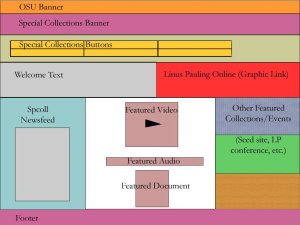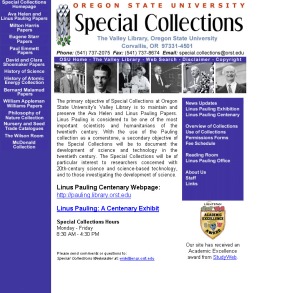In September 2007, we decided that the time had come to redesign our home page and department web presence. Last month, three graphic designers, dozens of mock-ups, hundreds of work hours and almost exactly two years later, we released our new look, complete with scads of fresh content. For those interested in many of the details of what’s new, here is the press release announcing the launch.
The objective of this post is to talk a bit about our process, but before getting into that, let’s have a look at the old homepage as well as that which has now replaced it.
The Homepage
The desire to revamp our site was spurred initially by the realization that all of our various Pauling projects were amounting to an urban sprawl of sorts, cluttering up the right-hand side of the homepage. The solution to this: Linus Pauling Online, a portal for all of the Pauling sites that could be linked to as a landing page from the Special Collections home and elsewhere, including the top-right corner of this blog.
The design for the Pauling portal was completed and released well before the site redesign was complete, but both projects were developed with the other in mind – aside from differing color schemes, the look and feel of the two pages are very similar.
Though the Pauling Online portal moved most of our Pauling resources off of the homepage, we still wanted to reserve some prime real estate for various featured projects – hence the “Featured” section, which currently links to the Pauling Centenary Conference, Linus Pauling Day-by-Day and the Pauling Chronology.
In a similar vein, now that we’re doing much more with video, it made sense to include a featured video component to the homepage. Currently that video is Dr. Roderick MacKinnon’s 2008 Pauling Legacy Award lecture, but the videos, as with the featured websites, will switch out with some frequency.
Lastly, the thousands of reference interviews that we’ve conducted over the years have given us a pretty good idea of the sub-pages on our site that are most heavily used. Links to those aspects of our site are now located prominently at the top of each of our redesigned pages, whereas some of the more ancillary content has been moved to the page footer.
Collections Pages
Another major component of the redesign project entailed an overhaul of our collections pages. Our objective here was to redevelop each collection index page into something more than an access point to information, but rather for the page to stand as something close to a digital exhibit devoted to the creator of each collection.
As such, aside from improving the finding aids for many of our archival collections (and, in certain cases, creating finding aids where before there were none) each of the fully processed collections now boasts of a featured document and, whenever possible, a featured video. Biographical timelines, improved administrative metadata and new illustrations complete the revamp.
The Fritz Marti Papers page is a good example of the striking difference between old and new. Plans are in the works for Omeka-based biographical exhibits that will further expound upon the life work of Marti and many others whose papers reside in the Oregon State University Libraries Special Collections.
Older Efforts
The launch of the 2009 redesign marks the fifth such release in the history of our department. Here’s a look at the evolution of our homepage over the years.

OSU Libraries Special Collections homepage, August 1998. Featuring rotating images and scrolling text.
Filed under: Site and Department News | Tagged: Fritz Marti, Linus Pauling, Omeka, Roderick MacKinnon, web redesign | 3 Comments »
































